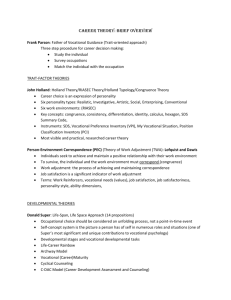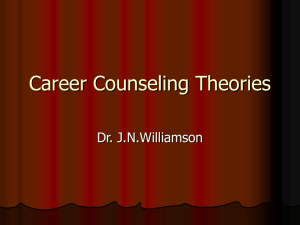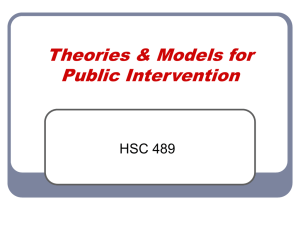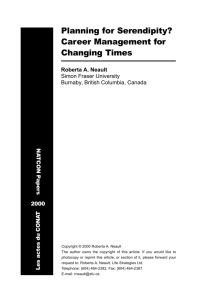Diagnosis in counseling
advertisement
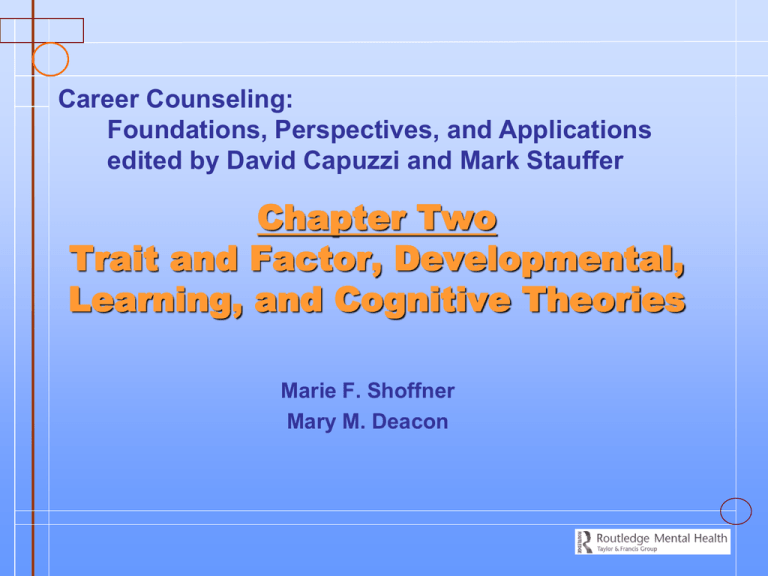
Career Counseling: Foundations, Perspectives, and Applications edited by David Capuzzi and Mark Stauffer Chapter Two Trait and Factor, Developmental, Learning, and Cognitive Theories Marie F. Shoffner Mary M. Deacon What is a Theory? A theory is “an attempt to represent some aspect of behavior, much in the same way that a map is an attempt to represent some geographic territory” (Krumboltz, 1994, p. 9). What is a Good Theory? “A good theory is a simplified representation of some domain constructed so that users can ask questions about that domain with an increased probability of receiving valuable answers” (Krumboltz, 1994, p. 12). Class assignment In groups of 3 – 4 students: Create a poster summary of the following theories: 1. Holland’s 2. Theory of Work Adjustment 3. Super’s 4. Gottfredson 5. Krumboltz – CBT and Planned Happenstance 6. Savickas 7. Hansen 8. Peavy 9. Schlossberg List the following on your poster: name of theory theorist classification core concepts of the theory Trait and Factor Approaches John Holland’s Theory of Career Choice Knowledge of the Individual Match Job & Individual Knowledge of the Job Trait and Factor Approaches John Holland’s Theory of Personality Types Realistic Investigative Artistic Social Enterprising Conventional Theory of Work Adjustment Dawis and Lofquist's TWA Work adjustment happens when an individual improves or maintains his or her fit or correspondence with the work environment. Theory of Work Adjustment Person-Environment Correspondence (PEC) It addresses how environment and person correspond to each other. Theory of Work Adjustment Reinforcement values (needs and values) e.g., Status, which includes the needs of Advancement, Recognition, Authority, and Social Status. Theory of Work Adjustment Satisfaction (also includes satisfactoriness as determined by the employer) Personality styles & Adjustment behaviors Theory of Work Adjustment PERSONALITY STYLE Celerity (speed of initiating environmental interaction) Pace (activity level of interaction) Rhythm (pattern of interaction) Endurance (sustainability of interaction), Theory of Work Adjustment ADJUSTMENT BEHAVIORS Individual levels of: Flexibility Activeness Reactiveness Perseverance Values-based Career Counseling Posits that values are the primary salient characteristic of career decision making, more so than individual interests. Individual/work congruence is a valuebased fit Developmental Theories Developmental theories provide a framework for understanding the unfolding process of career and career choice over the lifespan. Donald Super’s Theory of Vocational Development Super assumed that an individual’s career choice was not merely the result of matching his or her abilities and interests to the world of work, but that it was an expression of his or her self-concept. Primary Life Roles Life role relates to behaviors, motives, and sentiments more than merely position Child Student Leasurite Citizen Worker Homemaker Partner Parent Pensioner Life Home School Work Community Arenas Life roles are exercised in four arenas. One role can be played out in several theaters. Major GROWTH Life EXPLORATION Stages ESTABLISHMENT MAINTENANCE DISENGAGEMENT Recycling of stages throughout life, “minicycles,” or a cycling through stages across the lifespan “maxicyle.” Life Space The constellation of life roles played out by individuals in life stages. Life-spaces differ between individuals because of personal factors (e.g., interests, needs, values,) and situational factors (e.g., family, culture, gender, societal forces). Life Role The importance of a role. Awareness of which life roles are Salience more or less important. Lifestyle The simultaneous combination of life roles. Life Cycle Sequence of life roles. Lifespan The course of life or “maxicycle” of stages. Life Structure The “career pattern” that results from role salience and structuring of various life roles. Linda Gottfredson’s Theory of Circumscription and Compromise Theory addresses how childhood influences career development and career choice. Vocational self-concept begins early in childhood and is defined through four orientations to work. Circumscription and Compromise Size and Power Ages 3-5 Gender Roles Ages 6-8 Prestige and Social Valuation Ages 9-13 Unique Self Ages 14+ Krumboltz’ Social Cognitive Career Theory Social Learning Theory of Career Decision Making (SLTCDM) Learning Theory of Career Counseling (LTCC) Krumboltz’ Social Cognitive Career Theory This theory recognized the importance of cognitive processes and behavior in career decision making, and explicitly addressed the influence of reinforcement and learning on the career development and choice processes. Social Cognitive Career Theory Genetics (Gender, race, physical characteristics, specific talents) Environment (Social, cultural, political, economic, geographic, and climate) Learning experiences (Both instrumental and associative) Task-approach skills (Including work habits, performance abilities, and thought processes) Cognitive Information Processing (CIP) The CIP approach to decision making and to career problem solving is designed to “help persons make an appropriate current career choice and, while doing so, to learn improved problem-solving and decision-making skills that they will need for future choices” (Sampson, Reardon, Peterson, & Lenz, 2004, p. 2). CASVE Cycle Communication Analysis Synthesis Valuing Execution Social Cognitive Career Theory (SCCT) Three important factors: 1.Person factors 2.Contextual factors 3.Experiential and learning factors Social Cognitive Career Theory (SCCT) Learning experiences shape self-efficacy beliefs and outcome expectations, and are influenced by factors such as educational opportunity and family context. SCCT Self-efficacy beliefs influence choice, actual performance, and persistence. Self-efficacy beliefs act as moderators between experience and career interests. Goal aspirations, and ultimately goal choices, are influenced by interests and by relevant self-efficacy and outcome expectation beliefs. Theories of Embedded Career Blustein’s concept of the embedded self (Blustein, 1994) or the self in relationship with others and the environment, career, and career development can be viewed as embedded in the larger context of social and environmental interchange and relationship. Theories of Embedded Career Contextualism Ecological Approach Sociological Theories Psychodynamic Approaches Psychodynamic theories of career development focus on issues of ego identity, life scripts, and life themes and are often extensions of the theories of Adler (life themes) and Erikson (ego identity development). References Blustein, D. L. (1994). Who am I?: The question of self and identify in career development. In M. L. Savickas & R. W. Lent (Eds.), Convergence in career development theories: Implications for science and practice (pp. 139-154). Palo Alto, CA: CPP Books. Krumboltz, J. D. (1994). Improving career development theory from a social learning perspective. In M. L. Savickas & R. W. Lent (Eds.), Convergence in career development theories: Implications for science and practice (pp. 9-31). Palo Alto, CA: CPP Books. Sampson, J. P., Jr., Reardon, R. C., Peterson, G. W., & Lenz, J. G. (2004). Career counseling and services: A cognitive information processing approach. Belmont, CA: Brooks/Cole.
